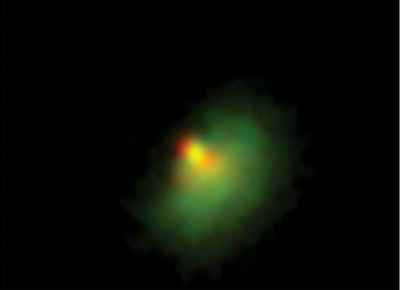Analysis of photographs taken after the impact of the "Deep Impact" spacecraft on the comet Temple 1 Maale, on the comet there are minerals that are formed only in the presence of water * The spacecraft moved to a temporary orbit until a new research target is determined

Infrared image of Comet Temple-1 during the July 4th outburst from Japan's Subaru Telescope in Hawaii
Researchers needed several months to crunch all the data collected in Operation Deep Impact in which she smashed a projectile on comet Temple-1. The latest studies published in the journal Science used the findings of three giant telescopes on Mount Mauna Kea in Hawaii. These photographs revealed that an amount of dirt that is needed on Earth for 25 loaded semi-trailers, burst out in the collision. The comet appears to be made of a complex mixture of silicates, water and organic components, below the surface.
Although comets form at the icy edges of the solar system, they appear to contain minerals that only form in a much warmer environment where liquid water is present. This is according to an analysis of photographs taken after the "Deep Impact" spacecraft hit Comet Temple 1.
On July 4, an intruder coming out of the spacecraft and moving at a speed of about 40 km/h collided with a comet. Following the collision, thousands of tons of ice and dust were ejected from the comet, which were photographed by telescopes in space and on Earth. One of them was the "Spitzer" telescope, which identified characteristics of infrared light, which testified that the comet contains clays and chalks (carbonates), substances that are formed only in the presence of water.
Spitzer also identified minerals called silicate crystals. Astronomers knew that comets contain silicates, but silicates form crystalline structures only when they are at a temperature of 700 degrees Celsius - a temperature that prevails in the region of Mercury, the planet closest to the Sun - and then cooled. Researchers are not sure how silicate crystals exist in a comet formed beyond the distant planet Pluto.
Dr. Kari Lisa from Johns Hopkins University, who presented Spitzer's findings to journalists last week, told the New York Times that there are several possible explanations for the existence of the minerals in the comet. One possible explanation is that the minerals formed because of an unexpected chemical reaction. Another explanation is that the minerals were formed at a much later stage, the last ten thousand years, when Temple 1 reached the inner, and hotter, regions of the solar system.
Deep Impact for a new route
On 21/7/05, 17 days after the successful mission of the crash of the bullet on the comet Temple-1, NASA requests to preserve the spacecraft for future missions. NASA personnel performed a changeover maneuver that would bring the spacecraft close to Earth on December 31, 2007.
Running the engines for 900 seconds changed the speed of the spacecraft by about 600 km/h and preserved the option that NASA has for future uses in hunting comets.
